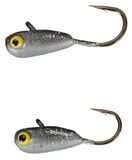Big Water Panfish
By: Bob Bohland
It should come as no surprise that most trophy panfish come from bigger waters. They have more forage, more habitat, and just more room for numbers of panfish to grow larger. Yet, many anglers only fish panfish on small to medium sized waters. Whether it is not realizing that there are fishable populations of good sized panfish in the bigger lakes, or whether it is just being hesitant about trying to find them amidst thousands of acres of water, they are missing out on some of the best trophy panfishing available. But with a little hard work, and a couple of tricks up your sleeve you can have all the panfish to yourself on big bodies of water.
While most anglers on smaller waters tend to go right towards weedy shorelines or bays, there can often be too much of this type of structure in a large lake for an angler to efficiently dissect. Many savvy big-water panfisherman don’t bother with near-shore structure. They know that it is easier to dissect the off-shore structure in a lake, leaving them less area they have to search. There are two different types of off-shore structure that produce good-sized panfish: Mud depressions, also known as “sticky-bottom areas” and humps or “sunken islands”.
Mud depressions can be in almost any depth of water, but the best areas to panfish generally occur between ten and twenty-five feet of water, and this is where you should focus your search. A lot of mud depressions can be very easy to find with a good lake map, there are many that will even show bottom content, though there can be many that will not be found without drilling a lot of holes. Knowing how to read a quality flasher like the new Marcum LX-7 will also help you find soft bottom areas. One of the most common places for mud to be is near the base of a dropoff where the bottom begins to level off into a flat. A large majority of the fish feeding in these muddy areas will be suspended as they chase around the aquatic invertebrates that hatch out of these areas. So you will need a bait that imitates these insects swimming around. The Lindy Bug is perfectly suited for this purpose, with large downward facing eyes that the fish can actually see, the Bug will dance around above the fish in ways that they can't resist.
Humps are an entirely different animal altogether though. They are easily found with even the most basic lake map. There are two main types of structure on humps, weeds and rocks. Most fisherman will tend towards the weeds, which will hold a lot of fish, but they will also hold smaller fish. Panfish that tend to feed on the rock humps will be larger and more aggressive. While the Bug works great in the weeds, when it is time to find the bigger fish on the rocks, tie on one of the new smaller sizes of the Lindy Slick Jig. Load a couple of larvae or a minnow head on it and pound it into the rocks, this will create a commotion that can bring panfish in from quite a distance.
Don't confine yourself to fishing smaller bodies of water this winter. Big lakes may take a little more work to narrow down a good pattern, but they are well worth the hassle for the size of the fish you will catch. Also since the majority of anglers who do fish big bodies of water are after walleyes and perch, you can have some amazing panfish spots to yourself all winter long.

No comments:
Post a Comment